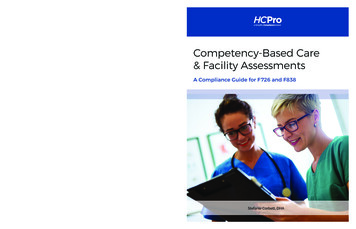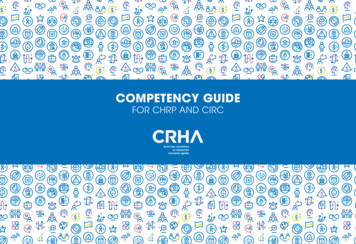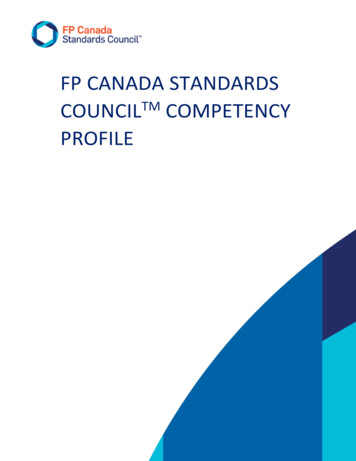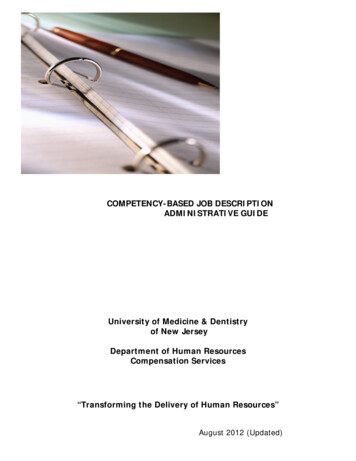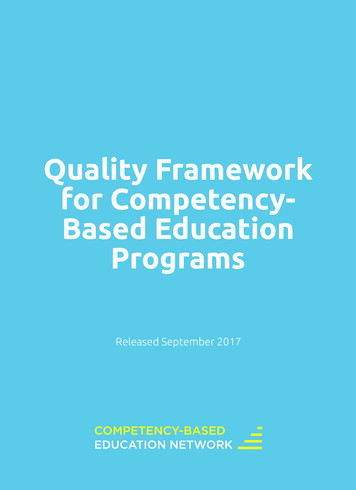
Transcription
Quality Frameworkfor CompetencyBased EducationProgramsReleased September 2017
C-BEN ContributorsQUALITY STANDARDS TASK FORCE MEMBERSDeborah Bushway, Ph.D.Jillian Klein, MACBE ConsultantLumina FoundationAssociate Vice President, Government Affairs & Public PolicyCapella UniversityKevin Corcoran, MBACharla Long, J.D.Strategy DirectorLumina FoundationExecutive DirectorCompetency-Based Education NetworkLaurie Dodge, Ph.D.Marni Baker Stein, Ph.D.Vice Chancellor of Institutional Assessment & Planning,Vice Provost, Brandman UniversityChief Innovation OfficerThe University of Texas SystemFrank Essien, MAAlison Kadlec, Ph.D.FacilitatorStrategy OfficerLumina FoundationSenior Vice President, Director of Higher Education &Workforce EngagementPublic AgendaMyk Garn, Ph.D.Assistant Vice Chancellor for New Learning ModelsUniversity System of GeorgiaMEMBER INSTITUTIONSAntioch UniversityBrandman UniversityBroward CollegeCapella UniversityCentral New Mexico CommunityCollegeCharter Oak State CollegeCity University of Seattle ConcordiaUniversity (WI)Kentucky University, Kentucky StateUniversity)Kentucky Community & TechnicalCollege SystemLipscomb UniversityLord Fairfax Community CollegeLos Angeles Trade-TechnicalCollegeNorthern Arizona UniversityDanville Community CollegePurdue UniversityDavenport UniversityRasmussen College (MN)DePaul UniversitySalt Lake Community CollegeExcelsior CollegeSouthern New HampshireUniversityKentucky Commonwealth(University of Louisville, WesternTexas Higher EducationCoordinating Board (SouthTexas College And Texas A&MUniversity-Commerce)Thomas Edison State UniversityUniversity of Maine at Presque IsleUniversity of Maryland UniversityCollegeUniversity of MichiganUniversity of Texas SystemUniversity of Wisconsin-ExtensionUniversity System of GeorgiaWalden UniversityWestminster CollegeSouthwestern College (KS)Quality Principles and Standards for Competency-Based ProgramsReleased by the Competency-Based Education Network with support from Lumina Foundation. Available online at www.cbenetwork.org.Copyright 2017 Competency-Based Education Network.Quality Framework for CBE Programs1Competency-Based Education Network
The C-BEN Quality Framework for CBE Programs was developed in response to a growingneed for definitions of quality relating to competency-based education. Led by the C-BENQuality Standards Task Force, this work drew from the Shared Design Elements and EmergingPractices of Competency-Based Education, and brought together leading program designersand system administrators from C-BEN institutions representing an array of models. Thistask force worked together over 2016 to create the first edition of Quality Principles &Standards for Competency-Based Education Programs through an iterative andinclusive process, developing principles and standards universal enough to apply to all CBEprograms, regardless of model variations. In the future, we envision these universal principlesand standards will be augmented by additional stackable principles and standards based onresearch as well as model-specific, programmatic features.Our aim with this work is to provide guidance to the field, allowing institutions to draw onthese principles and standards to inform the design, implementation or scaling of high-qualityprograms. The principles and standards also can provide guideposts and assurances topolicymakers and accreditors tasked with regulating this vibrant, and still emerging, field ofpractice. The process of developing these standards has been inclusive of both the entire C-BENcommunity and the wider field. Not only did C-BEN members from 30 institutions and four stateuniversity-systems offer feedback, but over a hundred other individuals from around the countryprovided guidance that informed this final version. In addition, a convening of roughly 40C-BEN members and more than a dozen national experts and regulators was held in late 2016to finalize the standards and begin ongoing work on development guides.The goal of the task force was to provide principles and standards that are at once accessibleand aspirational. This is achieved by the use of performance indicators embedded in theDevelopment Guides designed to make the principles and standards multidimensional. Theperformance indicators for each of the principles were also released in May 2017, andfeedback was gathered from Spring, 2017 C-BEN convening attendees as well as throughan online portal established to solicit feedback from the field. This feedback has now beenincorporated into the Development Guides which are available on the C-BEN website.As evidence emerges regarding the efficacy of CBE program design, it is time to put a significantstake in the ground around quality. The future of the movement depends on our ability to do so.But C-BEN knows full well that the evolution of the field and the growth of the evidence base willrequire that these principles and standards be regularly revisited and updated to reflect the stateof knowledge. This edition of the Quality Framework for CBE Programs is intended to informstrong program design, ease accreditation, and build the confidence of regulators working tocreate safe space for responsible innovation. Ongoing refinement and revision from the fieldat-large will be necessary to ensure its’ use and relevancy in building and refining qualitycompetency-based education programs.Quality Framework for CBE Programs2Competency-Based Education Network
Key Definitions to Aid UnderstandingElements, principles, standards, performance indicators and development guidesform the backbone for this work. The Quality Framework focuses on the programas the unit of analysis, and begins by articulating elements, principles, andstandards of quality for CBE program design and implementation.For clarity’s sake, the terms used in this document are defined below:Element: The label or shorthand for the principle being describedPrinciple: A fundamental proposition that serves as the foundation for a systemof belief, or behavior, or for a chain of reasoningStandard: A level of quality or attainment, and an idea or thing used as ameasure, norm or model in comparative evaluationsPerformance Indicators: A measurement that describes how effectively aninstitution is achieving the principle and standards.Development Guides: A set of scaffolded performance indicators intended toallow programs to understand stages of development for a CBE program. Eachstage (from “Initial” to “Highly Developed”) is intended to build on and includethe expectations from the previous stage.Download a digital copy of the Quality Frameworks forCompetency-Based Education Programs at cbenetwork.orgQuality Framework for CBE Programs3Competency-Based Education Network
Quality Framework for Competency-BasedEducation ProgramsEight Elements of Quality1Demonstrated Institutional Commitment to andCapacity for CBE Innovation2Clear, Measurable, Meaningful and IntegratedCompetencies3Coherent Program and Curriculum Design4Credential-level Assessment Strategy withRobust Implementation5Intentionally Designed and Engaged Learner Experience6Collaborative Engagement with External Partners7Transparency of Student Learning8Evidence-driven Continuous ImprovementQuality Framework for CBE Programs4Competency-Based Education Network
1Demonstrated InstitutionalCommitment To and CapacityFor CBE InnovationDemonstratedInstitutionalCommitment Toand Capacity ForCBE Innovation
Demonstrated Institutional CommitmentTo and Capacity For CBE Innovation1PRINCIPLEIn order to produce a high-quality CBE program, the institution must build a foundationalinfrastructure in support of competency-based education. This includes the development ofa CBE philosophy and commitment as it relates to the institution’s mission, the design of theprogram structure and the definition of appropriate supports for the program and its learners(including people, policy and process supports). The institution must also make appropriatefinancial investments in the program, understanding that the returns on investment (ROI) forCBE programs are generally longer-term, and recognizing that such investments are oftennecessary both to achieve regulatory and accreditor compliance and to provide learners with anadequate and appropriate support structure.2STANDARDS1. The institution’s senior leadership and board members understand the role CBE programsplay in furthering or enhancing the institution’s mission, and support the creation, continuousimprovement and ongoing growth of CBE programming.2. The institution has defined its approach to competency-based education, including the degree ofautonomy given to programmatic-level design and delivery.3. The institution has developed and adopted a faculty and staff model that meets the unique needsof its CBE program and complies with internal governance processes and controls while efficientlyutilizing institutional resources.4. The institution has developed policies and procedures for its CBE program that support learningand the learner experience while maintaining compliance with regulatory requirements.5. The institution maintains, across relevant academic and non-academic departments, sufficientadministrative capability and commitment to manage and support competency-based educationprograms.6. The CBE business model, including the tuition structure, has been analyzed to determine feasibilityand sustainability.7. The institution has evaluated the technology needed to support the learner lifecycle (such asstudent information systems, financial aid delivery systems and learning management systems) and,where appropriate, made investments.8. The institution has a plan for data collection and reporting regarding the learning experienceand the efficacy of the CBE program. These data form the basis for examination and discoveryof needed improvements in areas such as learner performance across diverse groups, graduatesuccess and employer satisfaction.Quality Framework for CBE Programs6Competency-Based Education Network
3PERFORMANCE INDICATORSC CriteriaI InitialE EmergingD DevelopedH Highly Developed1. The institution’ssenior leadershipsupports the CBEprogram.Institutional leaders (e.g.,senior leadership andboard members) have beeninformed of a competencybased education programat the institution, and theprogram administration andfaculty may have a plan inplace for program launch.Institutional leadershave been informed ofa competency-basededucation program atthe institution (via boardmeetings, academicleadership meetings, etc.)and initial action steps or aplan is in place for programlaunch and sustainability.Institutional leadersunderstand how the CBEprogram supports theinstitution’s mission, andadvocate for allocation ofresources for the program.Clear action steps are in placefor program sustainability,including program design, agrowth plan and a continuousimprovement plan.The institutional leadershipteam has articulated thelong-term ROI for CBE;approved a long-term actionplan; and made investmentsin the launch, scaling andsustainability of the institution’scompetency-based educationprogram.2. The institutionhas defined itsCBE philosophy.Institutional awareness ofand buy-in for competencybased education is isolatedto a specific program and/or the faculty and staff.There is currently no planfor improving awareness ofCBE across the institution.The institution is activelyconsidering a competencybased education approach(e.g., analyzing the costbenefit ratio relative toa customized programoffering). The institution isactively working towarda common understandingregarding competency-basededucation and the assessmentof learning for the institution(e.g., faculty workshops, draftstatements, etc.).The institution clearlyarticulates and agreesupon a common definitionfor competency-basededucation and has a sharedunderstanding of how theassessment of learning takesplace. Ongoing action stepsare being taken to improveinstitution-wide awarenessand engagement (e.g.,institutional focus or advisorygroups).The institution actively shares itsclearly articulated institutionaldefinition of competency-basededucation both internally andwith external partners. Focusedconversations result in anincreasingly clear commonunderstanding of the institution’sCBE philosophy, and actionsteps are defined to implementinstitution-wide changes insupport of it (e.g., transcriptionor policy changes).3. The institutionhas adopted afaculty and staffstructure thatsupports theunique needs ofthe CBE program.A traditional faculty andstaff model is in place.New models that supportlearning in a CBE programhave been articulated.Action steps towardthis new model and/orspecialized roles (e.g.,assessment specialist,instructional designer,coach) are defined.Faculty and staff positiondescriptions reflect anintentional model designedto support the CBE learnereffectively.Learner needs for supportare well-understood, andfaculty and staff modelsreflect those needs. Facultyand staff members identifiedfor specialized roles areaware of, have participatedin training for, and agree ontheir roles and responsibilities.The institution continues torefine the faculty and staffstructure to support the CBEprogram based on data,including learner satisfactionand performance data.4. The institutionhas CBE policiesand proceduresin place tosupport learnersuccess andmeet regulatoryrequirements.The policies and proceduresrequired to support the CBEprogram (e.g., attendance,tuition and fees, transferpolicies, transcription ofcompetencies, etc.) arebeing considered. Keyinternal stakeholders(e.g., registrar, businessoffice, provost’s office,information technology)and external stakeholders(e.g., accrediting bodyapprovals, federal andstate regulations) havebeen identified and anaction plan is in progress tomeet learner and programneeds.At least half of the relevantpolicies & the attendantprocesses (e.g., attendance,tuition and fees, transferpolicies, credit hourequivalencies, SAP) tosupport the CBE programhave been revised. Keyinternal stakeholders(e.g., Registrar, BusinessOffice, Provost’s Office,Technology) and externalstakeholders (e.g.,accrediting body, federallegislation) are engagedin the ongoing revisionprocess. The institutions isactively pursuing regulatoryapprovals. An action plan isin progress to meet studentand program needs.The policies and proceduresthat are unique to theinstitution’s CBE program(e.g., attendance, tuitionand fees, transfer policies,competency masteryassessment, satisfactoryacademic progress) areestablished (i.e., are in alearner handbook) and inpractice to meet learnerand program needs. Theinstitution has securedprogram approval for itsrespective competencybased education program,as needed. Key faculty andstaff are working to monitorprogram compliance withthese approvals.The CBE program usesthe information gleanedin its systematic processfor improvement to informits budgeting and projectplanning processes, andbases future programiterations and innovations onthis roadmap for continuousimprovement.Quality Framework for CBE Programs7Competency-Based Education Network
PERFORMANCE INDICATORS (CONTINUED)C CriteriaI InitialE EmergingD DevelopedH Highly Developed5. The institutionmaintainssufficientcapability andcommitment tomanage andsupport its CBEprogram.The institution has identifiedthe resources needed tosupport its CBE learnerseffectively, includingfaculty, staff, informationtechnology and otheradministration.The institution has a realisticand viable plan to supplythe required resources as itsCBE program launches andgrows.The institution has approval toimplement its plan to supplythe required resources as itsCBE program launches andgrows.The institution has integratedits resource plan with itsbusiness model and iscommitted to incrementalresource addition andmodification as the programscales.6. The CBE business model hasbeen analyzedfor feasibility andsustainability.A business model has beendrafted and reviewed withkey internal stakeholders(e.g., chief financial officer,provost’s office, boardmembers). A hypotheticallyfeasible and sustainablebusiness plan has beencreated.A feasible and sustainabledraft business model hasbeen approved by key internal stakeholders.The institution is monitoringthe performance of its CBEprogram against the primarylevers identified in its businessmodel. Adjustments are madeas needed to ensure theprogram’s sustainability.The institution has adequatedata to continuously analyze its CBE business model,including the tuition structure,and is willing to share whatit has learned with other CBEinstitutions. The CBE programis financially self-sustaining.7. The institutionhas evaluatedthe technologyneeded tosupport theCBE learnerexperience, andhas invested asneeded.Technology systems (e.g.,LMS, SIS, CRM, financialaid billing) have beenevaluated to plan forCBE program needs andfunctionality.The institution has identifiedgaps in current technicalsystems’ and processes’abilities to support the CBEprogram, and has createda roadmap to fill those gaps(which could include usinga blend of current and newsystems). Initial changeshave been made.The institution has reviewedall technology systems inplace to support the CBElearner ecosystem and,where appropriate, madeinvestments.The institution has developedan integrated set oftechnology systems to supportthe CBE learner ecosystem. Itactively shares its processeswith other CBE institutionsand uses its data to help themimprove their solutions.8. The institutionhas a datacollection planthat supportsa continuousimprovementeffort.The institution has identifiedprogram success measuresand key performanceindicators (e.g., programobjectives, learnerperformance acrossdiverse groups, enrollment,graduate success, employersatisfaction).The institution hasdeveloped and resourceda plan for data collection(e.g., faculty and staff effort,learner success, cost model)that aligns to the CBEprogram’s success measuresand key performanceindicators.Program success measuresare clearly defined andagreed upon by the faculty.A data collection processis established. Data areused to monitor programeffectiveness and efficiencyas well as to inform strengthsand needed improvementsacross a variety of areas(e.g., program objectives,learner performance acrossdiverse groups, enrollment,graduate success, employersatisfaction).The institution has adopteda sustainability plan that isagreed upon by institutionalleadership as well as byprogram faculty and staff.The institution has dedicatedresources to the continuousimprovement of the CBEprogram, and shares itslearnings with the broaderCBE community.Quality Framework for CBE Programs8Competency-Based Education Network
2Clear, Measurable,Meaningful and IntegratedCompetenciesClear, Measurable,Meaningfuland IntegratedCompetencies
Clear, Measurable, Meaningful andIntegrated Competencies1PRINCIPLEEach competency is explicitly stated and provides unambiguous descriptions of what a learnermust master to complete a program of study. Each competency includes the theory and theapplication of theory required for mastery at the appropriate level for the credential beingearned. Each competency connects to content and learning activities designed to supportlearners in developing the proficiencies required by the program to award a credential. Eachcompetency is measurable and can be reliably and validly assessed.2STANDARDS1. Competencies represent explicit knowledge, skills, abilities and intellectual behaviors, balancingtheory and application in a demonstration of mastery.2. Competencies are co-constructed with input from diverse communities such as employers, expertpractitioners, subject matter experts, faculty, learners, advisory committees, recent graduates andprofessional or licensing bodies.3. Individual competencies are relevant, current and accurately depict the needs of employers andsociety.4. Competencies are capable of anchoring, specifying and guiding the learner experience, includingcurricular design, the development of instructional content, activities, remediation offerings andthe assessment strategy.5. Individual competencies are aligned to cognitive levels of learning using recognized taxonomies—such as the DQP (Degree Qualifications Profile), or Bloom’s Taxomony—and/or industry standardsQuality Framework for CBE Programs10Competency-Based Education Network
3PERFORMANCE INDICATORSC CriteriaI InitialE EmergingD DevelopedH Highly Developed1. Competencies representrequired knowledge, skills,abilities and intellectualbehaviors, and balancetheory and application.Credential-levelcompetencies aredefined.Competency definitionsexplicitly include theknowledge, skills,abilities and intellectualbehaviors required todemonstrate competency.Credential-levelcompetency definitionsinclude applicationstandards and clearlystate what is requiredfor demonstration ofcompetency.The institution gathersdata regarding learnerperformance on each ofthe competencies. Externalvalidation data (fromemployers, licensing exams,etc.) are used to strengthenlearner performance.2. Competencies are coconstructed with inputfrom diverse stakeholders,including employers, expertpractitioners, subject matterexperts, faculty, learners,advisory committees, recentgraduates and professional orlicensing bodies.Input from anadvisory group isintegrated into thecompetency development process.Competencies arereviewed by experts inthe field for relevanceand clarity. Tools suchas the DQP are used toensure the appropriatelevel of rigor for thecredential being earned.Stakeholders (suchas employers, expertpractitioners, subject matterexperts, faculty, learners,advisory committees,recent graduates andprofessional or licensingbodies) participate indefining credential-levelcompetencies.The program has a processto continuously review andrevise competencies asdisciplines evolve over time.Employers of graduatesprovide feedback regardingwhether the competenciesyield better-preparedgraduates.3. Individual competenciesare relevant, current andaccurately depict the needsof employers and society.Individual competencies are definedto reflect currentneeds.Individual competenciesare aligned to statedemployer and communityneeds.Individual competenciesreflect the current assessedneeds of both employersand society.The institution has a processthrough which it assesses thechanging needs of employersand society in order tomaintain the currency,relevancy and accuracy ofthe CBE program’s statedcompetencies.4. Competencies anchor,orient and guide the learnerexperience.Competencies aredefined clearlyand specifically,providing learnersa base for theirlearning journey.The competencyframework is wellarticulated anddefined so that thelearning journey cansupport competencydevelopment.The learning journey andthe assessments entailedare well-integratedwith and aligned to thecompetencies.There is a continuousimprovement model in placethat clarifies any ambiguouscompetencies, supportinga clearer pathway to thecredential for learners.5. Individual competenciesare aligned with thecognitive and behaviorallevels of learningappropriate for thecredential being earned,as well as with recognizedtaxonomies (such as theDQP or Bloom’s) and/orindustry standards.Competenciesare definedappropriately forthe credential levelbeing earned.The competencyframework supportsa scaffolding ofcompetency levels thataligns with learners’entry level capabilitiesand credential-levelrequirements.The competency frameworkis aligned, as appropriate,with recognized frameworksand taxonomies and/orindustry standards.The competencies andcompetency framework arerevised as external standardsand frameworks evolveso that they maintain theirlinkage to the cognitive levelappropriate to the credentialbeing earned.Quality Framework for CBE Programs11Competency-Based Education Network
Coherent Programand Curriculum Design3Coherent Programand Curriculum Design
Coherent Programand Curriculum Design1PRINCIPLECompetency-based education programs use an intentional and transparent approach tocurricular design that provides a learner with the full range of competencies necessary tomeet post-graduation demands. These programs intentionally seek to reduce racial, ethnic,socioeconomic, gender and other potential bias in their design, delivery and implementation.This academic model, which provides clear pathways to completion, builds a unified body ofknowledge that leverages frameworks, disciplines, standards, national norms, workforce andsocietal needs. Learners are at the core of the program’s design, and the logic of the program(as well as its associated assessment strategy) supports flexibility in pacing. The curriculardesign ensures that the level and complexity of the competencies are congruent with theachievements required for the academic level of the credential.2STANDARDS1.The set of competencies is clearly specified and provides easy-to-understand pathways that illustratewhat the learner must know and be able to do in order to progress in and complete a credential.2.The program encompasses an integrated curricular sequence that scaffolds learning at appropriatecognitive levels leading to mastery while affording the learner flexibility in the time spent to reachmastery.3.The set of credential-specific competencies, chosen through a co-constructed process, represents thecomplete taxonomy of the knowledge, skills, abilities and intellectual behaviors required by academia,the workforce and society to evidence a prepared and proficient credential holder.4.Learners can articulate what they should know and what they should be able to do upon completionof the program.5.Learners have meaningful access to faculty subject matter experts who play an active, central role inthe design and delivery of the program.6.Learning environments, content, communications, activities and assessments are accessible to andinclusive of each learner, based on identified needs.7.Learners are offered varied learning exercises, activities and experiences to promote theirengagement and provide multiple opportunities for the development of competency mastery.8.The program is designed to support individual learners with personalized learning pathways as theydevelop and master competencies.Quality Framework for CBE Programs13Competency-Based Education Network
3PERFORMANCE INDICATORSC CriteriaI InitialE EmergingD DevelopedH Highly Developed1. The entire setof competenciesis clearlyspecifiedand providespathways forlearners.Credential-levelcompetencies areclearly and transparentlyarticulated for learners,faculty, staff and otherstakeholders.Pathways for credentialcompletion are clear andshared with learners,faculty, staff and otherstakeholders.Along with credential-levelcompetencies and clearpathways, it is clear howlearners progress toward andcomplete a credential, evenwhen they may struggle with acomponent.Data regarding learnerprogression are collectedthrough the pathways, andcurricular improvements aremade when barriers areidentified.2. The programhas an integratedcurricularsequence thatscaffolds learningat appropriatecognitive andbehaviorallevels for eachcredential whilealso supportingflexibility forlearners.Learners in the programattain and demonstratecompetencies throughoutan integrated curriculum.The integrated curriculumscaffolds learningalong the pathways thatlead to demonstrationof competency at theappropriate cognitive andbehavioral level for thecredential. (For example,intentionally differentexpectations exist for an AAthan an MS.)The integrated curriculumaffords the learner flexibilityin the time spent to reachmastery while scaffoldinglearning at the appropriatecognitive and behavioral levelfor the credential.The program collects andanalyzes data regardinglearners’ rate of progressionthrough the curriculum withan eye to any inequities inlearner performance. Dataare also used to validate thatlearning is occurring at theappropriate cognitive andbehavioral levels to removebarriers, offer support and inform continuous improvementof the curriculum.3. The set ofcredentialspecificcompetenciesrepresentsthe completetaxonomy ofknowledge,skills, abilitiesand intellectualbehaviorsrequired forsuccess.The credential-level set ofcompetencies is comprehensive, cohesive, andappropriate to the credential being granted.The credential-level set ofcompetencies has beenreviewed and validated bystakeholders such as employers, community leadersand faculty for representinga complete taxonomy ofrequired competencies.When appropriate, the setof competencies is validatedagainst established toolssuch as the Degree Qualifications Profile (DQP).The credential-level set ofcompetencies is co-constructed with stakeholders to represent the complete taxonomyof knowledge, skills, abilitiesand intellectual behaviorsrequired by academia, theworkforce and society toevidence a prepared andproficient credential holder.The set of credential-specificcompetencies is validated using employer data as well asother achievement data, andchanges to this set of competencies are made basedon data, changing externalrequirements and learner performance following credentialcompletion.4. Learnerscan articulatecompetencies.Learners can articulatewhat they should know andwhat they should be able todo upon completion of theprogram.Learners can describethe competencies for thecredential for which they arestudying.Learners are able to interprettheir own data to understandtheir progression toward“knowing” and “being able todo” the defined competenciesupon graduation.At graduation, learners areable to demonstrate what theyknow and are able to do.5. Learners havemeaningfulaccess to andcan engagewith faculty tobenefit from theirexpertise.Faculty are readily available to learners as theyprogress through theprogram.Learners have meaningfulaccess to faculty subjectmatter experts who play anactive, central role in thedesign and delivery of theprogr
Marni Baker Stein, Ph.D. Chief Innovation Officer The University of Texas System Alison Kadlec, Ph.D. Facilitator Senior Vice President, Director of Higher Education & Workforce Engagement Public Agenda Quality Principles and Standards for Competency-Based Programs Released by the Competency-Based Education Network with support from Lumina .







